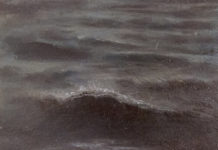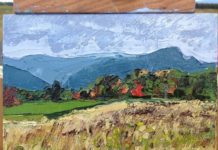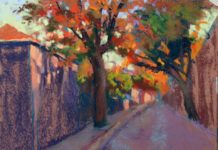
Huntsville’s pond, in Utah’s Ogden Valley, is John Huerta’s favorite place to paint, but it’s not so much the pond itself but the setting, the moss, and the lesson the place once taught him.

The pond in the Ogden Valley that inspires John Huerta
“The first painting of this pond was done in the late afternoon, and it was a breakthrough for me,” says Huerta. “I was just getting back to plein air painting. That can be a struggle anyway, but when it’s new to you, plein air can be pretty rough. But this time, it was kind of magical. It just came together. And I just sort of fell in love with the place.”

“Late Summer Sun,” by John Huerta, 2013, oil on canvas board, 8 x 10 in.

“Pond Reflections, 2007, oil, 14 x 11 in.
Huerta has since returned to the spot when he finds himself stuck. “It’s become an artistic reset for me, for lack of a better term,” says the artist. “I go to that pond if I am struggling with my painting or need to recharge.” One experience at the pond also serves as an important reminder for him that sometimes the most important thing an artist can do is stop, look, and ponder. During a plein air competition in the area, Huerta decided to go to his lucky spot for a painting, but shortly after he arrived it began raining heavily. He had only done a basic block-in before the rain came — no value system, no dark-light pattern. Huerta decided to wait it out, and he sat in his car until the storm broke. When he finished the painting under clearing skies, the result was a strong piece. “I sat for close to an hour in the car,” Huerta recalls. “But being able to sit there and think about where I wanted this thing to go if I got another crack at it was very beneficial. Since then, from time to time I make a conscious effort during a painting to not rush, to take a moment to pause and look at what’s going on on the canvas and think about it as interpretation.”

“Duck Pond,” by John Huerta, 2011, oil on canvas board, 8 x 10 in.
The artist likes the look of the scene, too, of course. He says he appreciates how the pond is framed by the mountains, and how the water reflects the mountains and trees. And then there’s the moss….

“Pond Study,” by John Huerta, 2009, oil, 11 x 14 in.
“Late summer is my favorite time, when the moss has developed,” says Huerta. “It can be electric green, and there’s a rusty color that develops. Initially the moss was kind of daunting. But I rely on what former teachers told me about painting in general: Get the general value and color intensity correct and it will resemble what you are trying to paint. Sometimes something like that moss is hard because you are seeing a color that doesn’t seem natural. For example, you have to keep the neon green quality of moss in check because if you key your painting to that it may not be good for the color harmony of the painting.”

The moss Huerta uses to add color, impasto, and compositional elements to his pond paintings
Technically, Huerta uses the fat-over-lean approach for the moss, applying a thick layer of moss color over the water color. The result is some impasto, with nice variation on the surface quality of the painting. The artist points out that “a little sometimes goes a long way,” and that the moss can be easily arranged in groupings that strengthen the composition. “Don’t go crazy with it and have moss everywhere, and remember to try to indicate that it is on the surface of the water,” he adds.





Thank you for posting such a fine review of Moab’s Plein Air Festival. Such a fantastic turn out of talent. The event needs more art appreciation participants to take home these fabulous renditions of Moab cameos.
Great coverage! Showcasing the talent of artists like these is a great service for those of us who live too far away to attend the event. Plus, it encourages us to check out their websites, galleries, or maybe even consider taking a workshop with them! It also helps acquaint us with artists with whom we’re not familiar. Thank you!
What is dry media, as apposed to Oil
the dry media appear to be pastel.